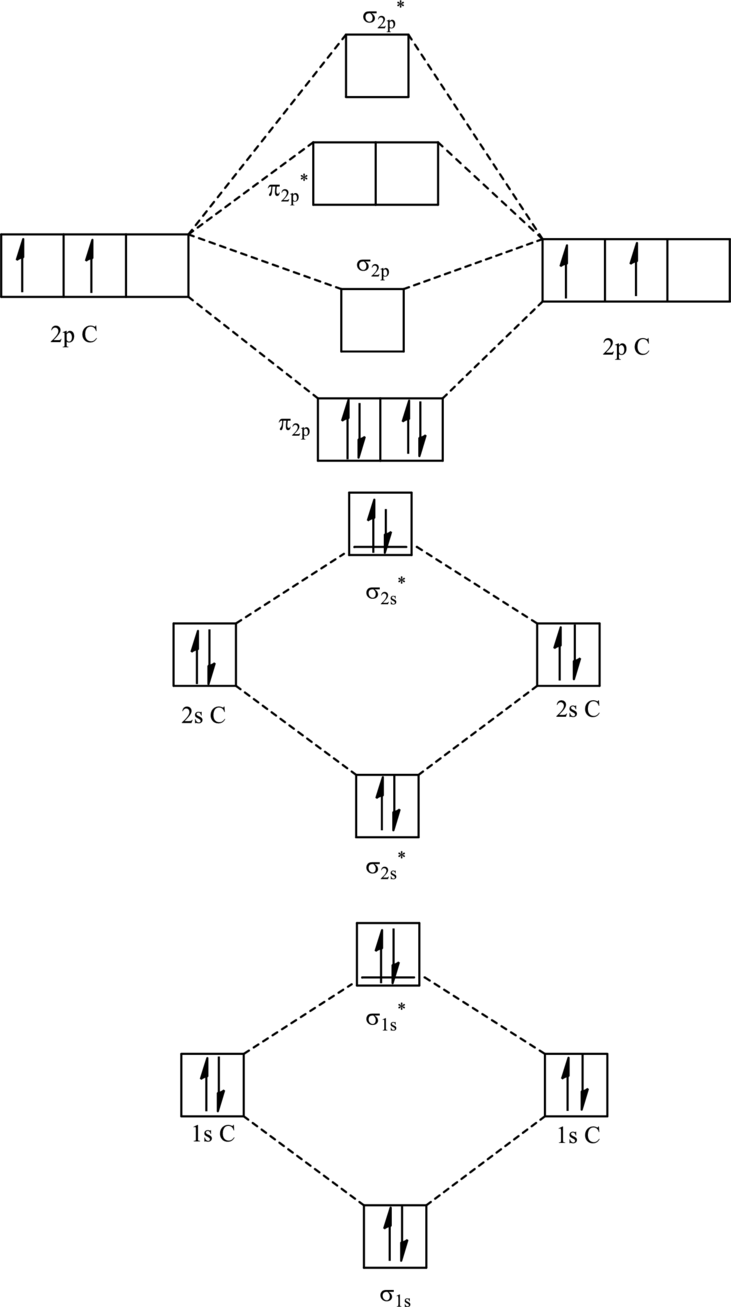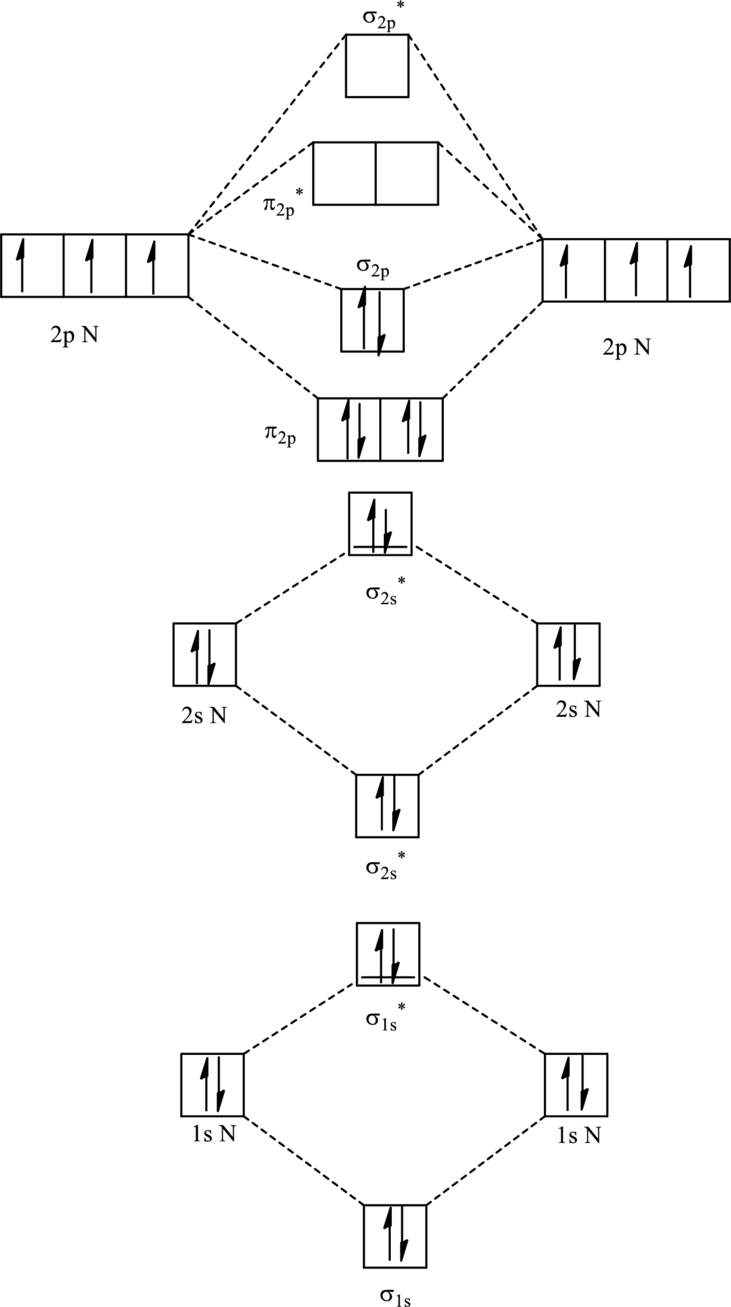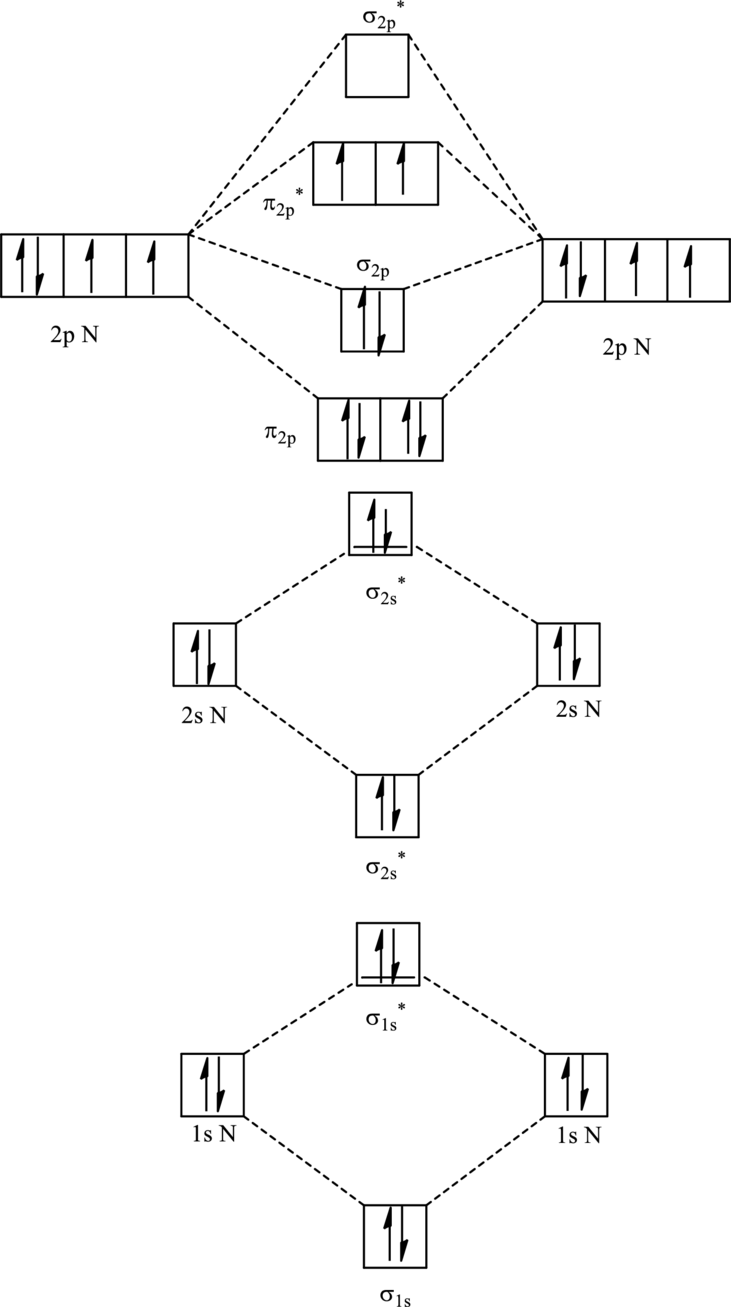
Concept explainers
(a)
Interpretation:
Changes in bond order, bond distance, and magnetic properties expected when
Concept Introduction:
Bond order is calculated by the expression given as follows:
The magnetic properties are related to terms such as diamagnetism and paramagnetism. Paramagnetism defines the ability of elements to be weakly attracted in an external magnetic field. It arises due to the presence of unpaired electrons. Diamagnetism defines the ability to be repelled in the external magnetic field environment. This is because diamagnetic species have paired electrons.
The bond length is estimated to be an average of covalent radii of two atoms within a bond. When bond order increases bond becomes stronger and bond length reduces. This accounts for shorter bond length in the case of unsaturated compounds while longer bonds in saturated compounds.
(a)
Explanation of Solution
For
The corresponding molecular orbitals in

Bond order is calculated by the expression given as follows:
Substitute 4 for anti-bonding electrons and 8 for bonding electrons in equation (1).
Thus bond order is 2 in
For
Substitute 4 for anti-bonding electrons and 7 for bonding electrons in equation (1).
Thus bond order is 1.5 in
Since the reduction in bond implies bond is longer thus the bond length is more in case of
(b)
Interpretation:
Changes in bond order, bond distance, and magnetic properties expected when
Concept Introduction:
Refer to part (a).
(b)
Explanation of Solution
For
The corresponding molecular orbitals in

Bond order is calculated by the expression given as follows:
Substitute 4 for anti-bonding electron and 10 for bonding electrons in equation (1).
Thus bond order is 3 in
For
Substitute 4 for anti-bonding electrons and 9 for bonding electrons in equation (1).
Thus bond order is 2.5 in
Since the reduction in bond order implies bond is longer thus the bond length is more in case of
Further in
(b)
Interpretation:
Changes in bond order, bond distance, and magnetic properties expected when
Concept Introduction:
Refer to part (a).
(b)
Explanation of Solution
For
The corresponding molecular orbitals in

Bond order is calculated by the expression given as follows:
Substitute 6 for anti-bonding electrons and 10 for bonding electrons in equation (1).
Thus bond order is 2 in
For
Substitute 5 for anti-bonding electrons and 10 for bonding electrons in equation (1).
Thus bond order is 2.5 in
Since the reduction in bond order implies bond is shorter thus the bond length is more in case of
Further in
Want to see more full solutions like this?
Chapter 2 Solutions
ACHIEVE/CHEMICAL PRINCIPLES ACCESS 1TERM
- What type of interaction would you expect between the following R groups in the tertiary structure of a protein? O -CH2-CO and -CH2-CH2-CH2-CH2-NH3+ a. disulfide bonds b. salt bridges c. hydrogen bonds HO abios vist anisinoo tedt bigil s ai loistaslor sale! 10 OUT d. hydrophobic interactions e. peptide bondsarrow_forward4. True or false: This skeletal structure represents a saturated fatty acid. Ini to 0 fale) me OH faistong starrow_forwardBy malonic or acetylacetic synthesis, synthesize 5-Methyl-2-hexanone (with the formulas of the compounds).arrow_forward
- QUESTION: Answer Question 5: 'Calculating standard error of regression' by filling in all the empty green boxes *The values are all provided in the first photo attached*arrow_forwardDraw the formula for 3-chlorobenzoic acetic anhydride.arrow_forwardBy malonic or acetylacetic synthesis, synthesize 2-methylbutanoic acid (indicate the formulas of the compounds).arrow_forward
- Obtain 2-methylbutanoic acid by malonic or acetylacetic synthesis (indicate the formulas of the compounds involved).arrow_forwardEFFICIENTS SAMPLE READINGS CONCENTRATIONS Pigiadient) TOMATO SAUCE (REGULAR) TOMATO (REDUCED SALT) TOMATO SAUCE (REGULAR) TOMATO (REDUCED SALT) 58 6.274 3.898 301.7 151.2 14150 5.277 3.865 348.9 254.8 B 5.136 3.639 193.7 85.9 605 4.655 3.041 308.6 199.6 05 5.135 3.664 339.5 241.4 0139 4.676 3.662 160.6 87.6 90148 5.086 3.677 337.7 242.5 0092 6.348 3.775 464.7 186.4 PART3 5.081 3.908 223.5 155.8 5.558 3.861 370.5 257.1 4.922 3.66 326.6 242.9 4.752 3.641 327.5 253.3 50 5.018 3.815 336.1 256.0 84 4.959 3.605 317.9 216.6 38 4.96 3.652 203.8 108.7 $3 5.052 3.664 329.8 239.0 17 5.043 3.767 221.9 149.7 052 5.058 3.614 331.7 236.4 5.051 4.005 211.7 152.1 62 5.047 3.637 309.6 222.7 5.298 3.977 223.4 148.7 5.38 4.24 353.7 278.2 5 5.033 4.044 334.6 268.7 995 4.706 3.621 305.6 234.4 04 4.816 3.728 340.0 262.7 16 4.828 4.496 304.3 283.2 0.011 4.993 3.865 244.7 143.6 AVERAGE STDEV COUNT 95% CI Confidence Interval (mmol/L) [Na+] (mg/100 mL) 95% Na+ Confidence Interval (mg/100 mL)arrow_forwardIf we have two compounds: acetone (CH₃COCH₃) and acetic acid (CH₃COOH), applying heat to them produces an aldol condensation of the two compounds. If this is correct, draw the formula for the final product.arrow_forward
- If we have two compounds: acetone (CH3COCH3) and acetic acid (CH3COOH); if we apply heat (A), what product(s) are obtained?arrow_forwardQUESTION: Fill out the answers to the empty green boxes attached in the image. *Ensure you all incorporate all 27 values (per column)*arrow_forwardYou need to make a buffer by dissolving benzoic acid and sodium benzoate in water. What is the mass of benzoic acid that you would weigh out, in mg, to create 50 mL of a buffer at pH = 4.7 that will change pH no more than 0.10 units with the addition of 0.001 moles of acid or base? Enter just the answer without the units (mg) - just the number will do!arrow_forward
 Chemistry: The Molecular ScienceChemistryISBN:9781285199047Author:John W. Moore, Conrad L. StanitskiPublisher:Cengage Learning
Chemistry: The Molecular ScienceChemistryISBN:9781285199047Author:John W. Moore, Conrad L. StanitskiPublisher:Cengage Learning
 ChemistryChemistryISBN:9781305957404Author:Steven S. Zumdahl, Susan A. Zumdahl, Donald J. DeCostePublisher:Cengage Learning
ChemistryChemistryISBN:9781305957404Author:Steven S. Zumdahl, Susan A. Zumdahl, Donald J. DeCostePublisher:Cengage Learning Chemistry: An Atoms First ApproachChemistryISBN:9781305079243Author:Steven S. Zumdahl, Susan A. ZumdahlPublisher:Cengage Learning
Chemistry: An Atoms First ApproachChemistryISBN:9781305079243Author:Steven S. Zumdahl, Susan A. ZumdahlPublisher:Cengage Learning Chemistry & Chemical ReactivityChemistryISBN:9781133949640Author:John C. Kotz, Paul M. Treichel, John Townsend, David TreichelPublisher:Cengage Learning
Chemistry & Chemical ReactivityChemistryISBN:9781133949640Author:John C. Kotz, Paul M. Treichel, John Townsend, David TreichelPublisher:Cengage Learning




